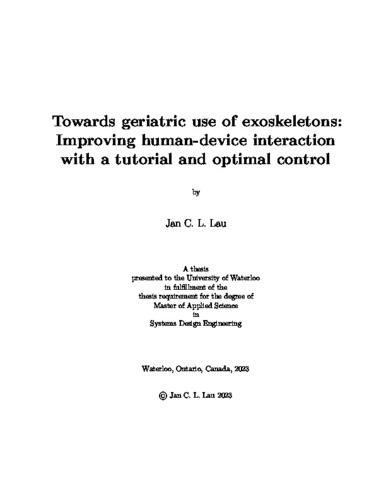| dc.contributor.author | Lau, Jan C. L. | |
| dc.date.accessioned | 2023-05-05 13:47:17 (GMT) | |
| dc.date.available | 2024-05-05 04:50:03 (GMT) | |
| dc.date.issued | 2023-05-05 | |
| dc.date.submitted | 2023-04-27 | |
| dc.identifier.uri | http://hdl.handle.net/10012/19422 | |
| dc.description.abstract | With the global geriatric population expected to reach 1.5 billion by 2050, there has been growing interest to tackle age-associated movement impairments by developing assistive technologies. Rehabilitative lower-limb exoskeletons have been primarily developed for people with spinal cord injuries. Since the needs of older adults are different than those of individuals with spinal cord injuries, the existing exoskeletons must undergo further modifications to be appropriate for the elderly. This thesis covers two preliminary approaches taken to improve human-exoskeleton interaction.
The first approach is to develop a novel protocol to teach first-time exoskeleton users how to move with the device. A pre-test involving two graduate students (healthy young adults) who had no prior exoskeleton experience suggests that moving with the device for the first time may be intimidating. It is assumed that this initial experience would be even worse for older adults. Moreover, there are little-to-no instructions provided on how to move with it, nor is there research done in this direction so far. To test the effectiveness of the developed protocol, a preliminary study was conducted with IIT’s TWIN exoskeleton. Due to COVID-19 restrictions, only healthy, able-bodied lab members could be invited. One group received the tutorial and the other group did not receive any training. The preliminary results suggest that the novel protocol is beneficial for first-time exoskeleton users and has a positive influence on the usability of the device, though this came at a cost of higher mental and physical demands and poorer perceived performance. Details on expanding the study to a larger population and making the tutorial suitable for older adults are discussed.
The second approach is an attempt to modify an existing lower-limb exoskeleton, which is originally made for a different target population, so that it would be suitable for older adults. Using optimal control and a simulation model of an elderly woman wearing TWIN, the crutch-less sit-to-stand trajectories are analyzed and generated. To first better understand the kinematics and forces of the movement involving a human-exoskeleton system, motion capture and force plate data on various ”crutched” and crutch-less sit-to-stand conditions are collected. Note that the crutch-less sit-to-stand scenarios do not reflect the intended use of the exoskeleton, but are collected to show the possibility of doing so with TWIN and analyze the underlying biomechanics. Motion analysis is performed on one of the crutch-less cases, allowing us to determine the torques needed to perform the motion successfully. The feasible solution is compared against an optimal solution obtained via motion synthesis. Similarities and differences between the feasible and optimal solutions are discussed. The limitations are identified and suggestions on formulating the optimal control problem to be suitable for the geriatric population are also discussed. | en |
| dc.language.iso | en | en |
| dc.publisher | University of Waterloo | en |
| dc.subject | optimal control | en |
| dc.subject | sit-to-stand | en |
| dc.subject | wearable robots | en |
| dc.subject | lower-limb exoskeletons | en |
| dc.subject | familiarization protocol | en |
| dc.subject | exoskeleton tutorial | en |
| dc.subject | assistive technology | en |
| dc.subject | ageing | en |
| dc.subject | elderly assistance | en |
| dc.subject | trajectory generation | en |
| dc.subject | motion analysis | en |
| dc.subject | motion synthesis | en |
| dc.subject | biomedical engineering | en |
| dc.subject | sit-to-stand biomechanics | en |
| dc.title | Towards geriatric use of exoskeletons: Improving human-device interaction with a tutorial and optimal control | en |
| dc.type | Master Thesis | en |
| dc.pending | false | |
| uws-etd.degree.department | Systems Design Engineering | en |
| uws-etd.degree.discipline | System Design Engineering | en |
| uws-etd.degree.grantor | University of Waterloo | en |
| uws-etd.degree | Master of Applied Science | en |
| uws-etd.embargo.terms | 1 year | en |
| uws.contributor.advisor | Mombaur, Katja | |
| uws.contributor.affiliation1 | Faculty of Engineering | en |
| uws.published.city | Waterloo | en |
| uws.published.country | Canada | en |
| uws.published.province | Ontario | en |
| uws.typeOfResource | Text | en |
| uws.peerReviewStatus | Unreviewed | en |
| uws.scholarLevel | Graduate | en |

